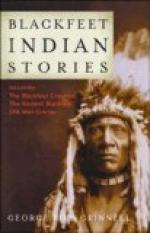It is often said that the buffalo were driven over these precipices, but this is true only in part. Like most wild animals, buffalo are inquisitive. It was not difficult to excite their curiosity, and when they saw something they did not recognize, they were anxious to find out what it was.
When run into the piskun, the buffalo were really drawn by curiosity almost to the jumping point, and between two long diverging lines of people, who kept hidden until after the buffalo had passed them, and then rose and showed themselves and tried to frighten the animals. Now, to be sure, for the short distance that remained between the place where they were alarmed and the place where they jumped, the buffalo were driven. Any attempt on the open prairie to drive buffalo in one direction or another would be certain to fail. The animals would go where they wished to. They would not be driven, though often they might be led.
To the people the capture of food was the most important thing in life, and they put forth every effort to accomplish it. For this reason it came about that the effort to capture buffalo was preceded usually by religious ceremonies, in which many prayers were offered to the powers of the earth, the sky, and the waters, many sacrifices made, and sacred objects, like the buffalo stone, were displayed.
When the day for the hunt came, the man who was to bring the buffalo left the camp early in the morning, climbed the rocky bluffs to the high prairie, and journeyed toward some near-by herd of buffalo, that had been located the day before by himself or by other young men. He approached the buffalo as nearly as he could without frightening them, and then, attracting the attention of some of the animals by uttering certain calls, tossed into the air his buffalo robe or some smaller object. As soon as the buffalo began to look at him, he retreated slowly in the direction of the piskun, but continued to call and to attract their attention by showing himself and then disappearing. Soon, some of the buffalo began to walk toward him, and others began to look and to follow those that had first started, so that before long the whole herd of fifty or a hundred animals might be walking or sometimes trotting after him. The more rapidly the buffalo came on, the faster the man ran—and sometimes it was a hard matter for him to keep ahead of the herd—until he had got far within the wings and near to the cliff. If there seemed danger that he would be overtaken, he watched his chance and either at some low place quickly dodged out of the line in which the buffalo were running, or hid behind one of the piles of stones of which the wings were formed, or, if he had time, slipped over the rocky wall at the valley’s edge, so as to get out of the way of the approaching herd.




